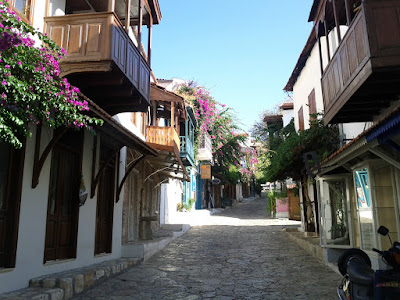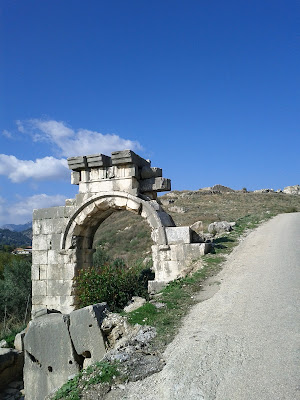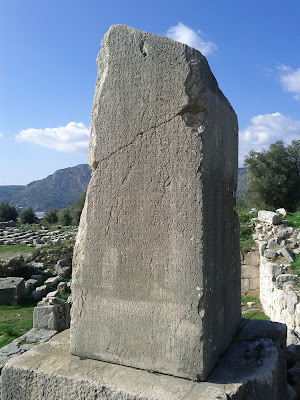Turkey is amazing in many ways, as we found out on a short four-day trip to the country. We took the evening Turkish Air flight out of Zurich, ended up in Istanbul at night, and took another plane a couple of hours later to Antalya in the south of Turkey. We checked in to a hotel and fell asleep. In the morning, a fantastic view of the Mediterranean greeted us.
 |
| The amazingly clean and sparkly-shiny Antalya airport. |
 |
| The view from our hotel room in Antalya. |
Just as we were wondering how wise it was to leave this spectacular room with a view and go somewhere else, our pick-up vehicle arrived as arranged. It costed about 50 CHF for a plane ticket from Istanbul to Antalya, and this car ride from Antalya to Kas would cost us about 100 CHF. Yay. It was a nice but mostly uneventful ride along the Mediterranean coast.
One thing we did notice was the number of greenhouses. Practically every village we passed, no matter how small, had half its area covered by greenhouses growing tomatoes. Orange trees grew everywhere; even the trees on the paved sidewalks were orange trees.
After about 2 hours, we finally arrived in Kaş.
The little "cedilla" on the "s" in "Kaş" turns the "s" into a "sh" sound (as in "sheep"). The same cedilla on a "c" turns it into a "ch" sound (as in "chocolate"). The Turkish language is a very interesting one for many reasons, not the least of which is their use of the Latin alphabet to form a purely phonetic script. In the late 1920s, a language reform replaced the old Ottoman Script, which looks a lot like Arabic to the untrained reader, with an extended Latin alphabet. We could read and pronounce most Turkish words (street signs, names of places, etc.) that we needed within a day of arriving, at least to the extent that the locals would know what we were talking about.
The words themselves are quite interesting. There are several words that one can easily recognize as being from Persian or Arabic. For example, we found some Arabic and Persian words in Turkish that made their way into Hindi as well such as, "Hava" = air, "diwan" = sofa, "Gül" = a rose, "Zamani" = an era or a period, "şehir" (pronounced exactly as in Urdu/Hindi, as "sheher") = a city, "Duniya" = the world, "Dikkat" = trouble/danger. At the same time, they have a lot of words from French. For example, "coiffeur" for a hairdresser's saloon, "guichet" for a counter, "jeton" for a token, and they say "pardon" for "excuse me". However, instead of spelling them like in French, they use the Turkish script to create the same effective pronunciations, thus ensuring that no matter what the origin of the loan word, you always pronounce a word the way it's spelled.
Having finally arrived at Kaş, we found ourselves in a deserted hotel in a deserted part of town, with a spectacular view and an empty beach all to ourselves. Turns out that Europeans don't much like water that is less than 25 degrees, so nobody comes to Kaş after October. This had us a bit worried - what if the water was too cold for diving?
 |
The omnipresent "Nazar" symbol. In this
case, this was embedded in the concrete
at the entrance to our hotel. |
Kaş was one of several nearby towns that were considered part of the region of Lycia as far back as the Bronze Age (~1200 B.C.). There are several easily accessible tombs, sarcophagi, and ruins from back then. So in the town of Kaş itself, we found a few Lycian structures. In the neighbouring town of Xanthos, supposedly once the administrative capital of the region of Lycia, we found an impressive complex of ruins including a temple, a court, an amphitheatre, rock-cut tombs, and sarcophagi. The town itself is a lovely little town with a cozy center, a town square by the docks, and a couple of lovely mosques built in characteristic Turkish style.
 |
This lovely view of the town of Kaş is from one of the Lycian
rock-cut tombs on the rocky hills next to the town,
Lycian |
 |
| Our hotel in the Çukurbağ peninsula. |
 |
| Houses near the town center of Kaş. |
 |
| Ramya in the town square, a large pedestrian-only paved area. |
 |
| A Greek amphitheater built into the rock slope in Kaş. |
 |
A Lycian monument, cut from a single rock.
This one is a very high sarcophagus with a
stone lid, and two lion heads on one side. |
 |
| A Lycian rock-cut tomb. Also in the town of Kas. |
 |
A lovely archway near the town of Xantos.
Xantos was apparently the administrative
and legal capital of the Lycians. |
 |
The entrance to the ruins of an amphitheatre. The two famous
Lycian tombs (the Harpy Tomb and the Pillar Tomb) are
visible in the distance. |
 |
| Ramya walking into the amphitheatre. |
 |
The Harpy Tomb (background) and the Pillar
Tomb (foreground). They're huge, at about 6.5m
in height. The Harpy Tomb has bas-reliefs that
look a bit out of place because they're replicas
that were made in recent times to replace the originals
that the Brits took away in the mid 1800s. The Elgin
Marbles aren't the only ones, apparently. |
 |
This was another site in Xanthos, supposedly a temple dedicated
to Artemis. There was still-intact mosaic flooring on the ground, so
the floor was covered with thick sheets and smooth pebbles were spread
over the sheets. |
 |
If you lifted up the sheets under the pebbles, you could still see
~2000-year-old mosaic flooring. |
 |
This pillar contains the longest surviving inscription
in the Lycian language, at 200+ lines |
We got around quite conveniently. Somehow, my Indian motorcycle license was good enough for a local vehicle rental shop to give us a Yamaha scooter. It was an ungeared scooter, but powerful enough to handle the tricky climbs in and around the area. We were in the Çukurbağ peninsula, and it was quite easy for us to use the scooter to the town. To go between towns, we used a "Dolmuş". These are small privately owned mini vans that ply between small towns in the region. They're very similar to the "tuktuks" in Egypt, and "tumtums" in Maharashtra in India, and are effectively shared taxis that will depart when somewhat full.
 |
| Ramya and I scooting about on the scooter. |
We took the Dolmuş to get to Xanthos and then tried to get to the nearby town of Patara, known to be a nesting site for turtles. The beach was too far and we were a bit tired, so we ended up abandoning the trip to the beach.
 |
| An awesome signboard on a shop in Patara. |
 |
| Ramya waiting at a crossroads for a Dolmuş van to show up. |
Kaş is best known outside of Turkey for being a fantastic diving destination offering very clear waters and varied marine life. The biggest attraction, at least for us, was the possibility of diving at one of several wrecks in the area. However, the diving season was all but over, and most dive schools had shut shop for the winter. We found one dive school that was willing to take us out on a huge 50-person boat which we had all to ourselves. Wasteful, I know. Our dive guide told us that that since the water was very cold (18 C), nobody wants to dive any more. Ramya and I stared blankly at her wondering if we even needed wetsuits at that temperature.
We ended up having a fascinating dive (and regretted not having an underwater camera) into the wreck of a C-47 plane. At 20m under the surface, in perfect visibility (~40m), we went into the plane, looked around, peeped into the cockpit, and swam around it a bit before surfacing. We went with Dragoman Adventures (
http://www.dragoman-turkey.com/t/12/). Five stars, highly recommended!
 |
About 20m down from here there's a huge plane with a 15m
wingspan. All you have to do is put on a dive mask or swim
goggles and you'll see it from the surface through the
cystal-clear water. |
 |
The Dragoman dive crew and us. The two cats in the picture are
part of the crew, and eagerly await the boat's return to the dock. |
 |
| The Dragoman dive boat was a self-contained dive center |
Having spent two days in the region, we got on a plane that took us to Istanbul in the middle of the night. I'm still not done writing about that part of the trip.




















No comments:
Post a Comment